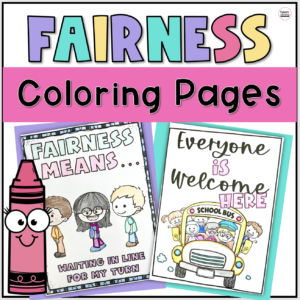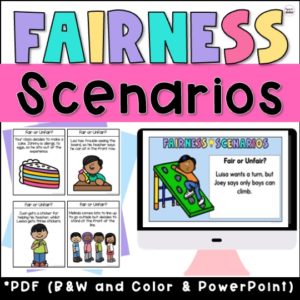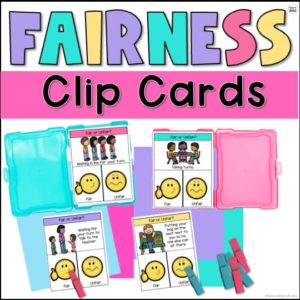“Fair is fair” is something we hear often in preschools, but let’s be honest—fairness is a tricky concept to grasp when you’re only 4 or 5 years old. Another favorite phrase? “That’s not fair!” And as we all know, explaining fairness to little ones often takes more than a quick five-minute chat.
From my experience, teaching fairness isn’t easy, but over the years I’ve found a few activities and strategies that really help. In this post, I’m sharing those ideas with you. By the end, you’ll have some practical ways to teach fairness to your preschoolers while also nurturing their budding sense of empathy.

Before I jump into the nitty gritty on how to teach fairness to preschoolers, I wanted to make sure you have downloaded my gift to you, Kindness Scenario Cards. These kindness scenarios will come in handy when developing a culture of kindness in your classroom. Click on the image below to start getting your students thinking about how they may sprinkle kindness into any situation.
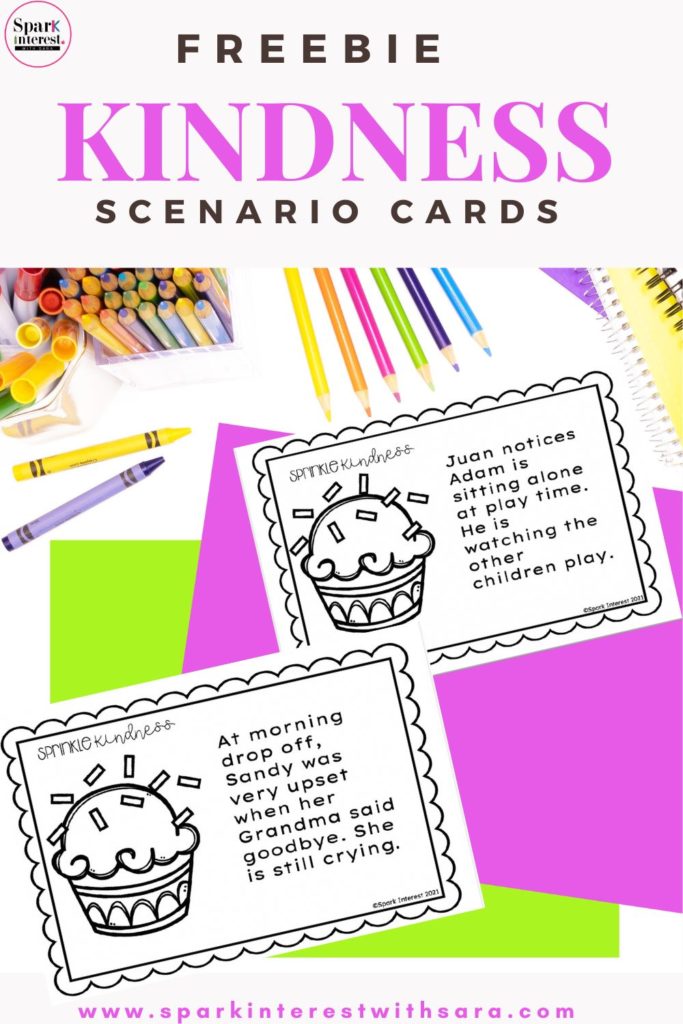
Why you should teach fairness to preschoolers
Fairness isn’t just about splitting things equally or taking turns. It’s a foundation for empathy, kindness, and respect—qualities that can guide kids throughout their lives. When we help children understand fairness, we’re empowering them to create a more just and caring world. And what teacher doesn’t want that?
By nurturing a sense of fairness, you’re doing so much more than teaching a life skill. You’re guiding your preschoolers to understand that sharing is caring, taking turns strengthens friendships, and treating everyone kindly makes the world a better place.
How to teach fairness to preschoolers?
Here are some simple, effective steps to introduce the concept of fairness to your little learners.
1.Sweets and Treats
When you begin teaching fairness, you want students to understand the concept and use relatable examples. Put students in pairs and give them an odd number of sweets. Ask them to divide the sweets between them fairly (Pro tip: Don’t mention the word “equally”—let them figure it out.) Once they’ve divided the sweets, start a conversation:
- How did they decide who got what?
- Was the outcome fair? Why or why not?
- Is everyone happy with the solution?
You’ll notice kids come up with all sorts of creative ways to share. This activity opens the door to a rich discussion about what fairness looks like in different situations.
2.Use Relatable Examples and Scenarios
We all hope our students will walk into the classroom with some sort of idea of fairness. However, that might not happen, and we need to figure out ways to show them examples. Using fairness scenarios is one way to entice students into the learning process and help them understand what fairness will look like in different situations. Here are some examples of scenarios in case you aren’t sure what I mean:
- Playground scenarios

- Classroom scenarios

- Center scenarios

Being able to recognize that it is hurtful to be unfair will establish the foundations for developing empathy. It will help your students see when unfairness happens, help them develop language around it, and help them see that unfairness hurts and that fairness doesn’t always mean equal.
You can also include kindness activities in your center time as well. Using fairness clip cards and identifying unfairness will help your students gain a greater understanding of how being unfair hurts others and will, in turn, help develop empathy. Clip cards are an easy activity that can be placed at a center and quickly checked before students move on. Developing kindness, empathy and fairness go hand in hand.

3. Group Fairness Discussion
As a group, come to a consensus on what fairness means in your classroom. Examples: fairness means ….being honest, following the rules, working together, etc. Have fun and role play scenarios – Act out unfair scenarios. After role-playing the scenarios and brainstorming ways to deal with each situation, discuss with students what they think are the qualities of fairness. Ask questions like how are each of the people feeling? How could we make the situation fair? Then act out a possible solution – what would that look like?
4.Read Books about Fairness
There are plenty of books that revolve around fairness and will help preschoolers understand the concept and give them some models and examples of what fairness is and how to show fairness. Some of my favorite books are:
Fair Shares by Pippa Goodhart
Bear and Hare are trying to get some juicy pears, and they need help. Hare finds three chairs, and they try to figure out if it’s fair for Hare to get two and Bear to get one. When they have the same, Hare can’t reach the pears! So another little friend teaches them that fairness isn’t always when everyone gets the same thing.
It’s Not Fair! by Amy Krouse Rosenthal
Life doesn’t always go the way we want it to. We often end up asking questions like, “Why’d I get the smaller half? She never gets yelled at! Why does my team always lose? Why can’t we have a pet giraffe? Because that’s life. This hilarious book reassures everyone, even pigs, plants, and pegs, that life can sometimes be unfair to them too.
Fair is Fair by Sonny Varela
Children often think their classmates or siblings are getting more. The question is, do special needs for one mean less love for another? The answer is explored using three zoo animals, and we learn that being equally loved doesn’t mean everyone is always treated the exact same. Love is expressed when everyone gets what they need.
Tips for Teaching Fairness to Preschoolers
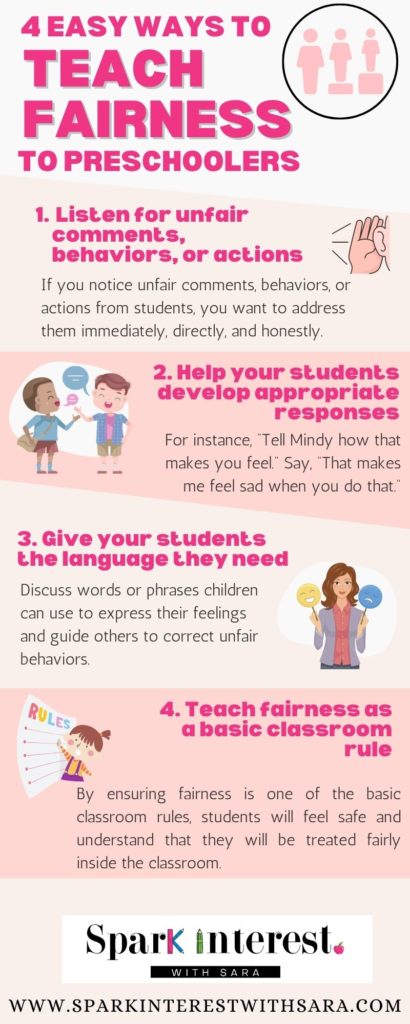
If you are looking to add some fairness lessons into your classroom, there are plenty of tips to make your lessons run smoothly and to ensure all students are learning and being appropriate.
Tip #1: Listen for unfair comments, behaviors, or actions
If you notice unfair comments, behaviors, or actions from students, you want to address them immediately, directly, and honestly. Use language students will understand, like “it makes Julianne feel sad when you tell her she cannot play with you.” or “All students share toys in our classroom, and you cannot tell someone they cannot play.”
Tip #2: Help children develop appropriate responses
When students are experiencing what they feel like in unfairness or when they are being treated unfairly, you want to help them develop the appropriate response. For instance, “Tell Mindy how that makes you feel.” Say, “That makes me feel sad when you do that.”
Tip #3: Give children the language they need
Ensure you talk about fairness and help your students learn how to talk about unfairness. Ask children to express their ideas about fairness and sharing—prompt children to talk about their feelings when they are treated unfairly. Discuss words or phrases children can use to express their feelings and guide others to correct unfair behaviors. For example, When we have our morning meeting, how can we ensure everyone gets a chance to share? Who has an idea how we can do that?
Tip #4: Teach fairness as a basic classroom rule
By ensuring fairness is one of the basic classroom rules or mottos, students will feel safe and understand that they will be treated fairly inside the classroom. They also will understand that if students are being unfair or are not being treated fairly, their teacher will handle it and help everyone become better learners.
Does fair always mean equal?
This is a challenging concept, even for adults. Many people see fairness as equal, and to make things fair, everyone needs to get the exact same things. However, as teachers, we definitely know this is not the case, and students often need more or less to make things fair. So students will get different things to create an equal environment.
How to Teach Fair Versus Equal to Young Learners: Step-By-Step
I’ve worked with preschoolers for many years and have found that they often struggle with the concept of equal vs. fair. Here is how I go about teaching this concept to my little ones.
Step 1: I usually have pictures of 3 different animals – a dog, a fish & rabbit to teach this concept.
Step 2: I begin by telling the students I will be fair. I give each animal a bone.
Step 3: Discuss whether that action is fair. Ask your students, “Is this fair?” “Does fair always mean equal?”
Step 4: Continue the discussion and ask the question, “What would make it fair for every animal?” Each animal gets exactly what they need – Dog-bone, fish-fish food, rabbit-carrot
Step 5: Discuss with students the idea of equality and fairness. Ensure students understand that giving everyone the same thing isn’t always fair.

The concept of fairness vs. equality is often a hard concept for preschoolers to comprehend, but if you use the tips, tricks, books, and fairness activities, students will be rockin’ and rollin’ before no time. Remember, students will need constant feedback, examples, and conversations to ensure they have the right picture of fairness. I hope these tips and tricks will answer your questions on how to teach fairness to preschoolers and help them develop empathy!
Some Resources You May Find Helpful:
- Do you need a no-prep fairness activity for your preschool, pre-k or kindergarten students? These 20 fun fairness coloring pages are a great addition to your unit on Fairness.
Fairness Coloring Pages
